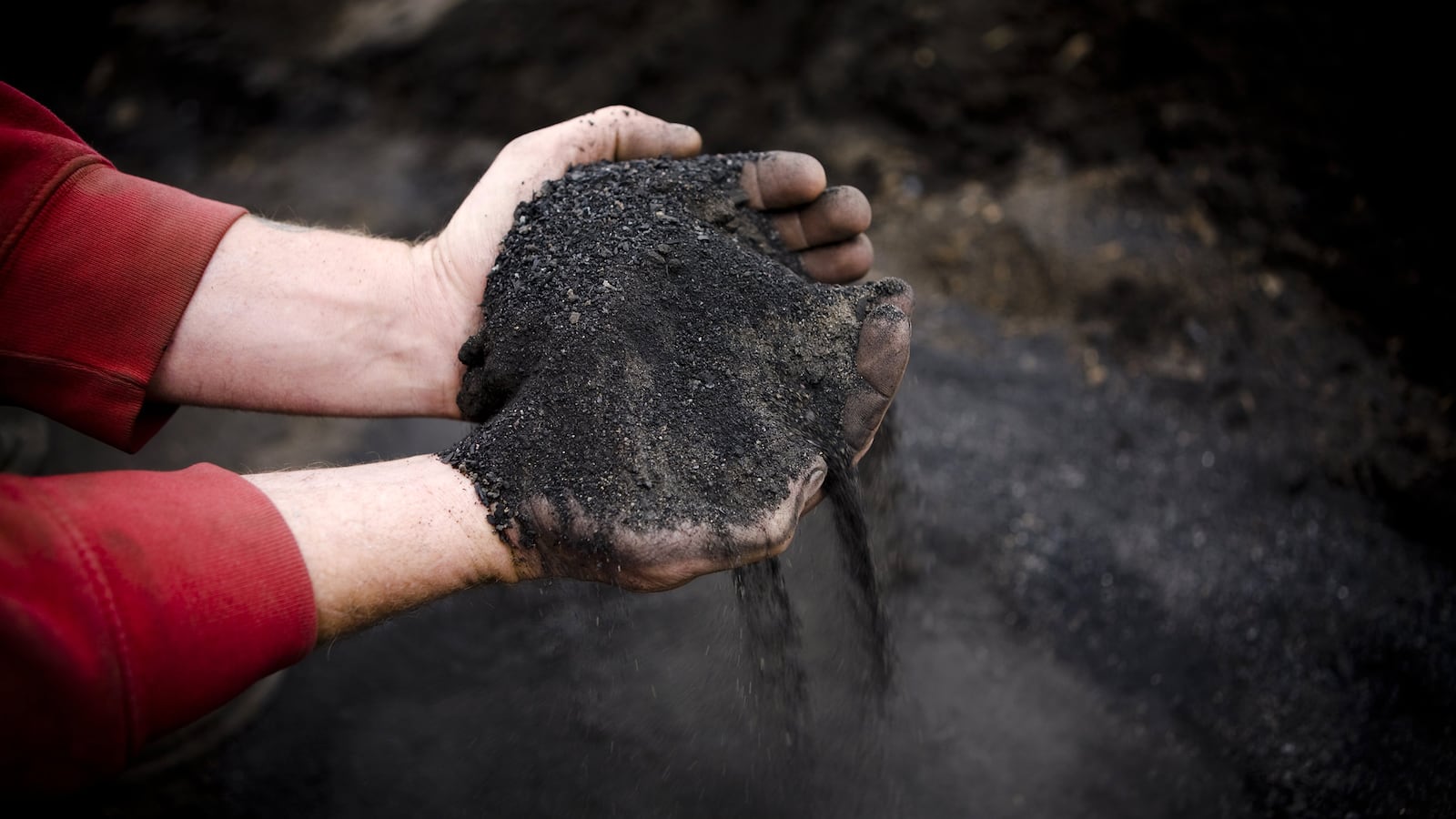California has a methane problem. The state’s dairy industry is the largest in the nation, but all those dairy cattle are producing more than milk. Foul-smelling slurry ponds of manure dot the Central Valley, and methane-producing bacteria thrive in these lagoons, expelling the potent greenhouse gas into the atmosphere.
But researchers at the University of California, Merced, are investigating a potential emissions mitigation tool for dairy farmers in the climate-conscious state, one that farmers around the globe have been using for millennia: biochar, a feather-light, pure black material that smells like charcoal and has the structure of a sponge.
Biochar, long championed by soil scientists, has become a darling of the climate mitigation movement as well for its ability to sequester carbon, as the impacts of climate change have grown increasingly apparent and destructive.
“It’s really an ancient technology,” said Rebecca Ryals, an agroecologist at the University of California, Merced. For generations, Indigenous communities in the Amazon put charcoal into the ground, transforming the region’s notoriously nutrient-poor soils into pockets of dark, fertile earth known as terra preta.
Today, biochars are created by burning wood, crop, and other organic waste at high temperatures and low oxygen—a process known as pyrolysis that creates a super stable structure that can lock up carbon for hundreds or even thousands of years. Of all the “negative emissions technologies” that the United Nations climate panel said humanity needs to pull carbon from the atmosphere and avoid catastrophic global warming, biochar is currently the only one that is technologically and economically feasible.
In 2010, research from Cornell University’s Johannes Lehmann suggested that as a soil amendment, biochar could drawdown up to 12 percent of global annual emissions—all while improving soil health, water retention, and crop yields for farmers. But so far it has not lived up to that potential.
“In the beginning of an industry, the price point is usually quite expensive, and expecting farmers to be the ones to adopt an expensive product was maybe the wrong first step,” said Kathleen Draper, the board chair of the International Biochar Initiative, an NGO that promotes the biochar industry. “We need to find markets that can afford biochar.”

Biochar laid out under the sun.
Melinda GonzalesA Whole New World
Fortunately, researchers are finding plenty of other places to put biochar besides croplands, from construction materials to orphaned oil wells to stormwater filtration sites. It can displace sand and other aggregates as a part of concrete, asphalt, and other composite materials, helping create something that may be lighter and more fire resistant than traditional concrete.
Moreover, all of these applications could boost not only the implementation of biochar, but also its potential as a carbon sink. The carbon sequestered in the biochar can also offset some of the cement industry’s massive carbon footprint, which accounts for a full 8 percent of global emissions.
The market is already becoming flush with these kind of biochar-infused materials, said Draper. She has incorporated biochar into the plaster walls of her own house in upstate New York—adding more than a ton of biochar to the ground around her septic system in place of sand.
Draper is currently working with the Environmental Protection Agency on a project adding biochar to drywall to displace gypsum—a mineral that’s usually minded or sourced from coal mines and flue stacks. The market potential is huge. In addition to building materials, biochar has been added to asphalt, to tires, to plastics, even to beauty products. With so many potential end products, one might worry that there’s not enough biochar to go around. But that’s not the case, according to Draper.
That’s because biochar is itself a waste management tool, and the U.S. has no shortage of waste. California, for example, has an endless supply of forest biomass from wildfire fuel reduction and agricultural waste from the Central Valley, where a quarter of the nation’s food is produced. Farmers often burn the orchard cuttings, husks, and other organic waste in the field, releasing those carbon stocks back into the atmosphere. But new legislation will ban this practice from 2025, which means the state’s farmers are looking for new ways to deal with all those waste products.
One promising solution: water filtration systems designed around biochar.

A worker slow burns sugar cane waste, part of the process in making biochar, at the Eco Fuel Africa factory in Lugazi.
Michele Sibiloni/AFP via Getty ImagesPurifier
Charles Hegberg first encountered biochar on a trip to Africa in 2006. Back then, when the restoration ecologist began looking into the research on biochar, much of it was still focused on the agricultural or carbon sequestration applications, but Hegberg was working on water quality issues in the Midwest and the Chesapeake Bay. “I had an epiphany at some point and was like, ‘wait a minute, this is a Brita filter,’” Hegberg said.
The activated carbon used in Brita filters is a porous material; pollutants become trapped in the tiny pores throughout the granules of carbon. Much of the activated carbon here comes from coconut shells shipped here from Asia, according to Gerardo Diaz, a mechanical engineer at the University of California, Merced. Certain waste materials and the right pyrolysis process can produce biochars with the kind of micropores necessary to trap different kinds of pollutants, and displacing activated carbon from coconut shells with local waste products would eliminate the emissions associated with those international shipments, Diaz added.
Eventually, wastewater treatment plants could incorporate biochar into their filtration systems. The California Association of Sanitation Agencies investigated the potential of using biochar made from drought-killed trees in wastewater treatment plants, for example, but the project failed to find a biochar filter that could compete with traditional activated carbon on price or efficiency.
Hegberg, now the vice president of business development at the environmental consulting firm Ecotone, is already using biochar to filter stormwater where it lands, by teaming up with cities and transportation departments in the Chesapeake Bay to identify green spaces that can be optimized to capture and filter more water during rainstorms.
Cities are largely impervious environments, where development has left most of the land capped with concrete and asphalt. Even in green spaces along roads and highways, or in grass-covered yards, the soils are so compacted that the water often runs off without infiltrating the ground. “You end up with a scenario where the soils are nothing more than green concrete,” Hegberg said.
Hegberg and his colleagues are turning these soil dead zones back into functioning ecosystems, first by fracturing the soil and then by adding a layer of biochar. The fracturing creates space for air and water to infiltrate the soil, turning it from a hostile environment for roots and microbes to one that’s teeming with microbial life. When storms occur, the water can better seep into these healthier, aerated soils, and passes through the biochar filter layer as it penetrates the ground.
“In the long run, if you can get it to scale, you can actually start reducing flooding,” Hegberg said. That will be a huge benefit for cities as climate change makes extreme weather events both more frequent and more severe.

A worker lays out biochar to dry in the sun before it is packed and distributed at the Eco Fuel Africa factory in Lugazi.
Michele Sibiloni/AFP via Getty ImagesSelling Points
As the California Association of Sanitation Agencies learned, not all feedstocks will make for great biochar filters. Finding the right market for all the different kinds of biochars out there is about matching the properties of the biochar to its intended use. One particularly tricky problem is what to do with contaminated biomass, like agricultural waste that’s laced with pesticides or sludge from wastewater treatment plants that contain heavy metals.
“There’s going to be some biochar being produced from things that might have heavy metals in them,” Draper said. “It’s just safer to put it in something that’s not used for growing food.”
These contaminated feedstocks might be ideal for creating biochars that could help turn abandoned oil wells into carbon sinks.
There are as many as 3 million orphaned oil wells across the United States, many of which may be leaking methane and other gasses. States and their taxpayers take on the responsibility of capping and abandoning these wells so they don’t pollute the environment any more than they already have. OFX EcoSolutions wants to turn these wells, which reach thousands of feet into the ground, into carbon sinks, by filling the space between the concrete plug at the bottom and the surface with biochar. They’re taking a holistic view of the abandonment process, using biochar to remediate the soil around the surface of the well as well.

Poultry farmer Josh Frye spreads churned out biochar from chicken waste and wood chips from a gasifyer on his land.
Jeff Hutchens/Getty ImagesThe company has piped biochar into a pilot well in Louisiana, and they are hoping to expand to Pennsylvania, Kentucky, Indiana, Michigan, and Colorado. “The reality is, on a well-by-well basis, we’re not moving the needle too much,” Mark Mersman, a co-founder of OFX, said. “You might be able to get 5 to 10 tons of carbon dioxide equivalent out of every well bore. But times a couple of million, that’s a pretty big number.” Even if only half of those 3 million abandoned wells wind up filled with biochar, and each of those accounts for the sequestration of 5 tons of carbon dioxide, that’s equivalent to the emissions from burning more than eight billion pounds of coal. And in addition to the nation’s defunct wells, there are nearly 1 million more active oil and gas wells that will be headed for retirement sooner or later.
Lehmann endorses an “all-of-the-above” approach for biochar applications. “The large numbers are to be [obtained] if we do both, mitigating a front-end issue and generating a back-end value for the soil,” he said.
This brings us back to Ryal’s work on biochar as an emissions mitigation tool for dairy manure. When she and her colleagues added biochar to composted manure, they found that it reduced the methane emissions by up to 80 percent (that data is not yet published but it is supported by previously published investigations). The biochar essentially “fluffs up” the compost ecosystem, Ryals said, and that extra oxygen allows aerobic microbes to outcompete the anaerobic, methane-producing microbes. Less carbon and nitrogen is lost to the atmosphere, and becomes stabilized in the compost itself.
The composting industry is already the largest buyer of biochar in the U.S., according to Draper. If the emissions reductions are the front-end benefit for the composting industry, the biochar compost itself is the back-end value. “You get one huge benefit from reducing methane during the composting pile, but then you also have this biochar composted material that provides all the nutrients in the compost and all of the carbon benefits from the biochar,” Ryals said. “When you do apply it to soil you get even bigger benefits that you would if any of those were applied alone.”
Eventually, that compost biochar fertilizer could still wind up in the ground—maybe even fertilizing the very crop fields the biochar feed stocks came from.



